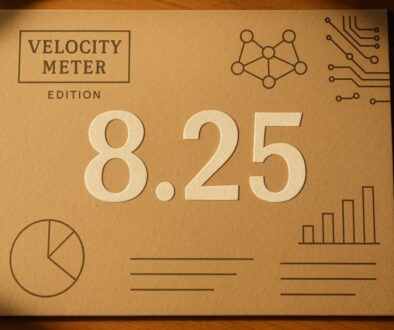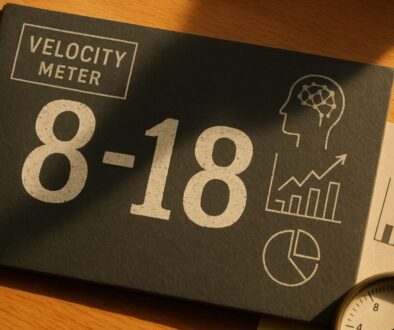Velocity Meter 9.2
🎼 The Orchestration Layer: When AI Stops Being a Tool and Becomes Your Workforce
While executives spent 2024 debating which AI tools to deploy, a quiet revolution unfolded in the trenches. AI evolved from individual productivity assistants into coordinated teams of specialized agents working together to handle complex workflows. Bain’s latest research reveals that companies achieving breakthrough AI results aren’t just using more tools—they’re orchestrating AI workforces that think, collaborate, and execute like human teams.
This isn’t about chatbots handling customer service or automating simple tasks. We’re entering the era of AI orchestration, where intelligent agents coordinate across departments, manage multi-step processes, and adapt to changing priorities with minimal human oversight. The most sophisticated implementations now feature AI teams that handle everything from manufacturing quality control to financial planning with the coordination and contextual awareness of experienced human teams.
The leaders emerging from the AI transformation plateau understand that success isn’t measured by the number of AI implementations but by how effectively these implementations work together to amplify human capabilities.
Let’s dive in.

🔄 From Individual Assistants to Coordinated Intelligence

The fundamental shift occurring across enterprises represents a maturation from viewing AI as sophisticated software to managing it as intelligent workforce. Organizations discovering sustainable AI advantage have moved beyond the “thousand pilot” approach to architect systems where multiple AI agents collaborate on complex objectives with the coordination sophistication of human teams.
The Operational Transformation Reality
Bain’s research on AI transformation exposes a critical insight: fewer than 20% of companies have successfully scaled generative AI beyond experimentation. The breakthrough factor isn’t technology sophistication—it’s operational integration. Companies achieving meaningful results treat AI deployment as business redesign rather than technology implementation.
The orchestration advantage becomes apparent when examining process transformation rather than task automation. Traditional AI deployments tackle individual functions: document generation, data analysis, or customer inquiry responses. Advanced orchestration systems coordinate multiple specialized agents that handle interconnected workflows—one agent identifies opportunities, another analyzes feasibility, a third generates proposals, and a fourth manages implementation timelines.
Manufacturing leaders like Michelin exemplify this orchestration mastery with over 200 AI use cases working in concert across production, quality control, supply chain management, and predictive maintenance. Their IRIS system doesn’t merely automate tire inspection—it coordinates with inventory management, production scheduling, and quality databases to optimize entire manufacturing workflows through AI team collaboration.
The Context Integration Revolution
The most sophisticated AI orchestrations solve what researchers call the “context problem”—the gap between isolated AI tools and business reality. Professional services implementations demonstrate how AI agents working together can handle complex legal workflows that previously required extensive human coordination.
Rather than deploying separate tools for contract analysis, document generation, and compliance checking, leading law firms now use orchestrated AI systems where specialized agents share context and coordinate decision-making. One agent might identify contract risks, trigger another agent to generate amendments, while a third ensures compliance verification—all working from shared understanding of client objectives and regulatory requirements.
Healthcare implementations show similar orchestration benefits. Instead of isolated scheduling software or separate billing systems, advanced clinics deploy AI teams that coordinate patient flow, staff scheduling, insurance verification, and follow-up care through integrated intelligence that understands both clinical and operational priorities.
Key Orchestration Capabilities:
-
Multi-agent coordination: Specialized AI systems collaborating on complex workflows
-
Context preservation: Shared understanding maintained across different AI functions
-
Adaptive execution: AI teams adjusting approaches based on real-time conditions
-
Human-AI collaboration: Seamless integration between human oversight and AI execution
The Competitive Advantage Architecture
Organizations mastering AI orchestration create advantages that competitors using isolated AI tools cannot replicate. Enterprise leaders report that coordinated AI systems deliver productivity improvements of 40-60% compared to 5-15% from individual AI tool deployments.
The orchestration advantage compounds through network effects. Each AI agent becomes more valuable as it connects with others, creating organizational intelligence that processes information and coordinates responses with increasing sophistication. Companies achieving breakthrough results describe AI systems that “think together” about business challenges rather than simply processing individual requests.
📌 Bottom Line: The AI transformation plateau ends when organizations stop thinking about AI tools and start building AI teams. Competitive advantage belongs to those orchestrating intelligent workflows, not just automating individual tasks.

🏭 AI Across Industries: Orchestration in Action

🏢 Financial Services: Intelligent Investment Operations
Financial services demonstrates the most sophisticated AI orchestration implementations, where multiple specialized agents coordinate across research, analysis, risk assessment, and portfolio management. Santander’s transformation showcases coordinated AI teams handling over 10 million voice transactions annually while processing investment analysis and regulatory compliance simultaneously.
The orchestration advantage becomes clear when examining complex financial workflows. Traditional AI implementations might automate individual tasks like document processing or basic analysis. Advanced orchestrations coordinate specialized agents that handle market research, regulatory compliance, customer communication, and risk assessment as integrated workflows. One agent identifies investment opportunities, triggers another to conduct due diligence, while a third ensures regulatory compliance and a fourth manages client communications—all coordinated through shared understanding of investment objectives and risk parameters.
📌 Takeaway: Financial institutions leveraging AI orchestration don’t just process transactions faster—they make superior investment decisions through coordinated intelligence that processes market data, regulatory requirements, and client objectives simultaneously.
🛠️ Manufacturing: Production Intelligence Teams
Manufacturing showcases AI orchestration through coordinated systems that manage quality control, predictive maintenance, supply chain optimization, and production planning as integrated workflows. Michelin’s implementation demonstrates how 200+ AI use cases work together to optimize entire production ecosystems rather than individual processes.
Advanced manufacturing orchestration coordinates specialized agents across design, production, quality control, and maintenance. When quality control agents detect potential issues, they automatically coordinate with predictive maintenance systems, supply chain management, and production scheduling to optimize responses. The result: manufacturing intelligence that thinks strategically about production optimization rather than reactively managing individual problems.
📌 Takeaway: Manufacturers implementing AI orchestration achieve production optimization that isolated AI tools cannot match through coordinated intelligence that balances quality, efficiency, and cost across entire manufacturing ecosystems.
🏥 Healthcare: Clinical Coordination Systems
Healthcare AI orchestration coordinates clinical care, administrative processes, patient communication, and regulatory compliance through specialized agents that share patient context and clinical objectives. Advanced clinic management systems demonstrate how orchestrated AI teams handle scheduling, patient intake, clinical decision support, and follow-up care as integrated workflows.
The orchestration advantage addresses healthcare’s complexity through coordinated intelligence. When patients arrive, AI agents coordinate across scheduling, insurance verification, clinical preparation, and care team communication. Clinical decision support agents share context with documentation systems, pharmacy coordination, and follow-up scheduling to ensure comprehensive care coordination without manual handoffs.
📌 Takeaway: Healthcare organizations implementing AI orchestration improve both clinical outcomes and operational efficiency through coordinated systems that manage patient care as integrated workflows rather than isolated tasks.
💼 Professional Services: Legal Intelligence Networks
Professional services demonstrates sophisticated AI orchestration through specialized agents coordinating research, document generation, compliance verification, and client communication. Legal implementations show how coordinated AI teams handle complex workflows like corporate incorporation, litigation preparation, and contract management through integrated intelligence systems.
Advanced legal orchestration coordinates specialized agents across research, analysis, document preparation, and compliance verification. When clients need corporate formation services, AI agents coordinate entity selection research, document preparation, regulatory filing, and compliance monitoring through shared understanding of legal requirements and client objectives. The result: legal intelligence that handles complex workflows with the coordination sophistication of experienced legal teams.
📌 Takeaway: Professional services firms implementing AI orchestration deliver superior client outcomes through coordinated systems that handle complex legal workflows with human-level coordination and expertise.

📊 AI by the Numbers: Quantifying the Orchestration Layer

🚀 95% – Percentage of traditional AI pilots that fail to scale compared to 67% success rate for orchestrated AI systems that coordinate multiple agents across business workflows, demonstrating the value of integrated rather than isolated AI implementations
🎯 200+ – Number of coordinated AI use cases at Michelin working together across manufacturing, quality control, and supply chain management, generating over €50 million in annual ROI through orchestrated rather than isolated AI applications
⚡ 40-60% – Productivity improvement range for orchestrated AI systems compared to 5-15% for individual AI tool deployments, highlighting the compound advantages when specialized AI agents coordinate across workflows
💰 87% – Percentage of CEOs expecting AI to augment rather than replace jobs, indicating the shift toward AI orchestration that amplifies human capabilities through coordinated intelligent systems
🔧 35% – Portion of workforce requiring reskilling to work effectively with orchestrated AI systems, up from 6% historically, reflecting the fundamental shift toward human-AI collaboration at scale

📰 5 AI Headlines You Need to Know

🧠 Harvard Study Reveals AI Experimentation Trap Costing Enterprises Billions Research exposes how “micro-productivity” AI implementations fail to scale, with most organizations trapped in pilot purgatory while competitors implement coordinated AI systems. The study emphasizes that breakthrough results require business process redesign with AI orchestration rather than tool deployment layered onto existing workflows.
🏭 Manufacturing Giants Report Breakthrough Results Through AI Team Coordination Leading manufacturers demonstrate that AI orchestration across quality control, predictive maintenance, and supply chain creates competitive advantages that isolated AI tools cannot match. Coordinated systems achieve 3-5x greater impact through shared context and workflow integration rather than individual task automation.
🔗 Fireflies Launches Claude Integration for Context-Aware Meeting Intelligence The platform connects meeting data with Claude’s AI capabilities, enabling coordinated intelligence that transforms conversational context into actionable insights. Teams now leverage AI orchestration across sales, product management, and customer success through shared meeting intelligence rather than isolated note-taking tools.
⚕️ Healthcare AI Orchestration Reduces Administrative Burden by 70% Advanced clinic management systems demonstrate how coordinated AI agents handling scheduling, patient intake, and care coordination create operational efficiency that individual healthcare AI tools cannot achieve. Orchestrated systems improve both clinical outcomes and staff satisfaction through workflow integration.
📊 Enterprise AI Leaders Report 4:1 ROI Through Coordinated Implementation Global organizations achieving AI transformation success implement coordinated systems rather than scattered pilots. Leadership emphasizes that sustainable AI advantage requires orchestrating specialized agents across departments rather than deploying individual productivity tools.

🎯 Final Take: Building Your AI Orchestra

The AI transformation plateau isn’t caused by technology limitations—it’s created by implementation thinking that treats AI as software rather than intelligent workforce. Organizations achieving breakthrough results have recognized that sustainable advantage comes from orchestrating AI teams rather than accumulating AI tools.
The research is unambiguous: companies stuck in the “micro-productivity trap” achieve modest efficiency gains while competitors implementing AI orchestration create competitive advantages through coordinated intelligence. The difference lies in architectural thinking—building AI systems that work together rather than independently.
The orchestration era demands different leadership approaches. Instead of evaluating individual AI capabilities, successful leaders focus on integration potential, context sharing, and coordination effectiveness. They treat AI deployment as workforce development rather than software installation, investing in systems that amplify human capabilities through intelligent collaboration.
The strategic imperative is clear: organizations that master AI orchestration—coordinating specialized agents across workflows while maintaining human oversight—will create advantages that competitors using isolated AI tools cannot replicate. The question isn’t whether your industry will adopt AI orchestration, but whether you’ll be orchestrating these systems or competing against organizations that mastered coordination first.
The orchestra is tuning up. Success belongs to the conductors.
📩 Ready to accelerate your AI transformation?
🎯 At Velocity Road, we help mid-market companies move beyond isolated AI pilots to build coordinated AI systems that work together like intelligent teams. From strategic planning to workflow redesign, we ensure your AI transformation creates sustainable competitive advantages through orchestration rather than accumulation.
Let’s discuss how we can accelerate your AI journey—schedule a consultation today.
📬 Forward this newsletter to colleagues who need to understand AI’s production reality. And if you’re not subscribed yet, join thousands of executives getting weekly intelligence on AI’s business impact.
Until next week,
The Velocity Road Team




